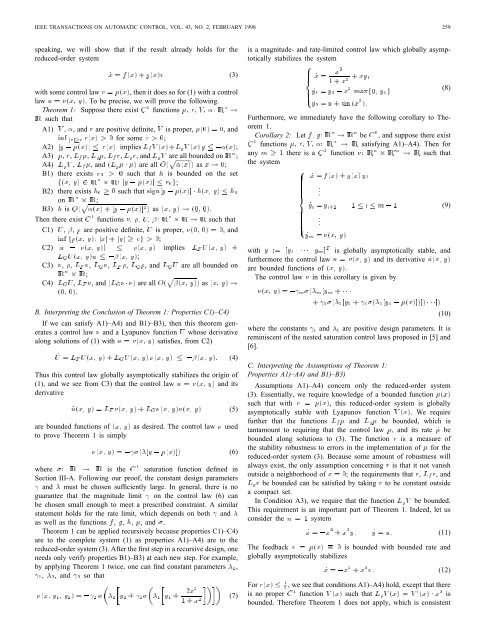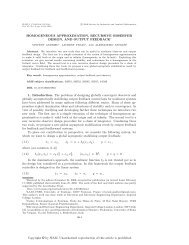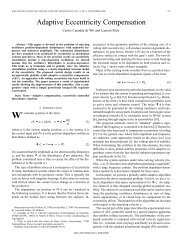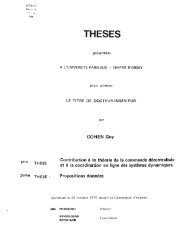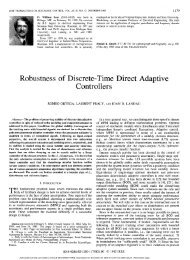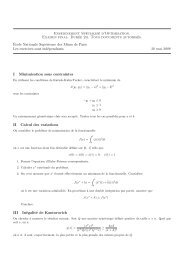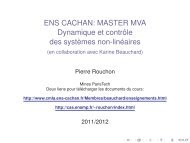Integrator Backstepping For Bounded Controls And Control Rates ...
Integrator Backstepping For Bounded Controls And Control Rates ...
Integrator Backstepping For Bounded Controls And Control Rates ...
You also want an ePaper? Increase the reach of your titles
YUMPU automatically turns print PDFs into web optimized ePapers that Google loves.
IEEE TRANSACTIONS ON AUTOMATIC CONTROL, VOL. 43, NO. 2, FEBRUARY 1998 259<br />
speaking, we will show that if the result already holds for the<br />
reduced-order system<br />
_x = f (x) +g(x)v (3)<br />
with some control law v = (x), then it does so for (1) with a control<br />
law u = (x; y). To be precise, we will prove the following.<br />
Theorem 1: Suppose there exist C 1 functions ; r; V; : IR n !<br />
IR such that<br />
A1) V , , and r are positive definite, V is proper, (0) = 0, and<br />
inf jxjc r(x) > 0 for some c>0;<br />
A2) jy 0 (x)j r(x)implies L f V (x)+L g V (x)y 0(x);<br />
A3) , r, L f , L g, L f r, L gr, and L gV are all bounded on IR n ;<br />
A4) L g V , L f , and (L g 1 ) are all O( (x)) as x ! 0;<br />
B1) there exists r 0 > 0 such that h is bounded on the set<br />
f(x; y) 2 IR n 2 IR : jy 0 (x)jr 0g;<br />
B2) there exists h 0 0 such that sign[y 0 (x)] 1 h(x; y) h 0<br />
on IR n 2 IR;<br />
B3) h is O( (x) +[y0(x)] 2 ) as (x; y) ! (0; 0).<br />
Then there exist C 1 functions ; ; U; : IR n 2IR ! IR such that<br />
C1) U, , are positive definite, U is proper, (0; 0) = 0, and<br />
inf f(x; y): jxj + jyj cg>0;<br />
C2) ju 0 (x; y)j (x; y) implies L F U (x; y) +<br />
L G U(x; y)u 0(x; y);<br />
C3) , , L F , L G, L F , L G, and L GU are all bounded on<br />
IR n 2 IR;<br />
C4) L G U, L F , and (L G 1 ) are all O( (x; y)) as (x; y) !<br />
(0; 0).<br />
B. Interpreting the Conclusion of Theorem 1: Properties C1)–C4)<br />
If we can satisfy A1)–A4) and B1)–B3), then this theorem generates<br />
a control law and a Lyapunov function U whose derivative<br />
along solutions of (1) with u = (x; y) satisfies, from C2)<br />
_U = L F U (x; y) +L G U(x; y) (x; y) 0(x; y): (4)<br />
Thus this control law globally asymptotically stabilizes the origin of<br />
(1), and we see from C3) that the control law u = (x; y) and its<br />
derivative<br />
_u(x; y) =L F(x; y) +L G(x; y)(x; y) (5)<br />
are bounded functions of (x; y) as desired. The control law used<br />
to prove Theorem 1 is simply<br />
(x; y) =0([y 0 (x)]) (6)<br />
where : IR ! IR is the C 1 saturation function defined in<br />
Section III-A. Following our proof, the constant design parameters<br />
and must be chosen sufficiently large. In general, there is no<br />
guarantee that the magnitude limit on the control law (6) can<br />
be chosen small enough to meet a prescribed constraint. A similar<br />
statement holds for the rate limit, which depends on both and <br />
as well as the functions f, g, h, , and .<br />
Theorem 1 can be applied recursively because properties C1)–C4)<br />
are to the complete system (1) as properties A1)–A4) are to the<br />
reduced-order system (3). After the first step in a recursive design, one<br />
needs only verify properties B1)–B3) at each new step. <strong>For</strong> example,<br />
by applying Theorem 1 twice, one can find constant parameters 1 ,<br />
1, 2, and 2 so that<br />
(x; y 1 ;y 2 )=0 2 2 y 2 + 1 1 y 1 + 2x2<br />
1+x 2 (7)<br />
is a magnitude- and rate-limited control law which globally asymptotically<br />
stabilizes the system<br />
_x =<br />
x3<br />
1+x 2 +xy 1<br />
_y 1 = y 2 0 x 2 maxf0; y 1g<br />
_y 2 =u+ sin (x 2 ):<br />
Furthermore, we immediately have the following corollary to Theorem<br />
1.<br />
Corollary 2: Let f; g: IR n !IR n be C 0 , and suppose there exist<br />
C 1 functions ; r; V; : IR n ! IR satisfying A1)–A4). Then for<br />
any m 1 there is a C 1 function : IR n 2 IR m ! IR such that<br />
the system<br />
_x = f (x)+g(x)y 1<br />
.<br />
_y i =y i+1 1 i m 0 1<br />
.<br />
_y m = (x; y)<br />
with y := [y 1 111 y m] T is globally asymptotically stable, and<br />
furthermore the control law u = (x; y) and its derivative _u(x; y)<br />
are bounded functions of (x; y).<br />
The control law in this corollary is given by<br />
(x; y) =0 m ( m [y m +111<br />
+ 2( 2[y 2 + 1( 1[y 1 0(x)])]) 111])<br />
(8)<br />
(9)<br />
(10)<br />
where the constants i and i are positive design parameters. It is<br />
reminiscent of the nested saturation control laws proposed in [5] and<br />
[6].<br />
C. Interpreting the Assumptions of Theorem 1:<br />
Properties A1)–A4) and B1)–B3)<br />
Assumptions A1)–A4) concern only the reduced-order system<br />
(3). Essentially, we require knowledge of a bounded function (x)<br />
such that with v = (x), this reduced-order system is globally<br />
asymptotically stable with Lyapunov function V (x). We require<br />
further that the functions L f and L g be bounded, which is<br />
tantamount to requiring that the control law , and its rate _ be<br />
bounded along solutions to (3). The function r is a measure of<br />
the stability robustness to errors in the implementation of for the<br />
reduced-order system (3). Because some amount of robustness will<br />
always exist, the only assumption concerning r is that it not vanish<br />
outside a neighborhood of x =0; the requirements that r, L f r, and<br />
L gr be bounded can be satisfied by taking r to be constant outside<br />
a compact set.<br />
In Condition A3), we require that the function L g V be bounded.<br />
This requirement is an important part of Theorem 1. Indeed, let us<br />
consider the n = 1system<br />
_x = 0x 3 + x 3 y; _y = u: (11)<br />
The feedback v = (x) 0 is bounded with bounded rate and<br />
globally asymptotically stabilizes<br />
_x = 0x 3 + x 3 v: (12)<br />
<strong>For</strong> r(x) 1 2<br />
, we see that conditions A1)–A4) hold, except that there<br />
is no proper C 1 function V (x) such that L gV (x) =V 0 (x)1x 3 is<br />
bounded. Therefore Theorem 1 does not apply, which is consistent


